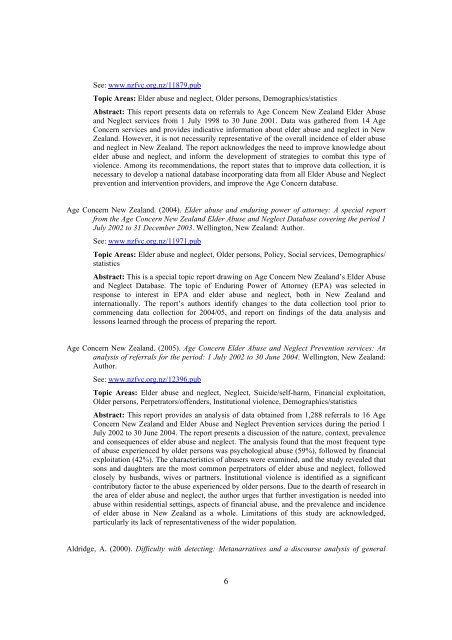annotated bibliography of new zealand research into family violence
annotated bibliography of new zealand research into family violence
annotated bibliography of new zealand research into family violence
Create successful ePaper yourself
Turn your PDF publications into a flip-book with our unique Google optimized e-Paper software.
See: www.nzfvc.org.nz/11879.pubTopic Areas: Elder abuse and neglect, Older persons, Demographics/statisticsAbstract: This report presents data on referrals to Age Concern New Zealand Elder Abuseand Neglect services from 1 July 1998 to 30 June 2001. Data was gathered from 14 AgeConcern services and provides indicative information about elder abuse and neglect in NewZealand. However, it is not necessarily representative <strong>of</strong> the overall incidence <strong>of</strong> elder abuseand neglect in New Zealand. The report acknowledges the need to improve knowledge aboutelder abuse and neglect, and inform the development <strong>of</strong> strategies to combat this type <strong>of</strong><strong>violence</strong>. Among its recommendations, the report states that to improve data collection, it isnecessary to develop a national database incorporating data from all Elder Abuse and Neglectprevention and intervention providers, and improve the Age Concern database.Age Concern New Zealand. (2004). Elder abuse and enduring power <strong>of</strong> attorney: A special reportfrom the Age Concern New Zealand Elder Abuse and Neglect Database covering the period 1July 2002 to 31 December 2003. Wellington, New Zealand: Author.See: www.nzfvc.org.nz/11971.pubTopic Areas: Elder abuse and neglect, Older persons, Policy, Social services, Demographics/statisticsAbstract: This is a special topic report drawing on Age Concern New Zealand’s Elder Abuseand Neglect Database. The topic <strong>of</strong> Enduring Power <strong>of</strong> Attorney (EPA) was selected inresponse to interest in EPA and elder abuse and neglect, both in New Zealand andinternationally. The report’s authors identify changes to the data collection tool prior tocommencing data collection for 2004/05, and report on findings <strong>of</strong> the data analysis andlessons learned through the process <strong>of</strong> preparing the report.Age Concern New Zealand. (2005). Age Concern Elder Abuse and Neglect Prevention services: Ananalysis <strong>of</strong> referrals for the period: 1 July 2002 to 30 June 2004. Wellington, New Zealand:Author.See: www.nzfvc.org.nz/12396.pubTopic Areas: Elder abuse and neglect, Neglect, Suicide/self-harm, Financial exploitation,Older persons, Perpetrators/<strong>of</strong>fenders, Institutional <strong>violence</strong>, Demographics/statisticsAbstract: This report provides an analysis <strong>of</strong> data obtained from 1,288 referrals to 16 AgeConcern New Zealand and Elder Abuse and Neglect Prevention services during the period 1July 2002 to 30 June 2004. The report presents a discussion <strong>of</strong> the nature, context, prevalenceand consequences <strong>of</strong> elder abuse and neglect. The analysis found that the most frequent type<strong>of</strong> abuse experienced by older persons was psychological abuse (59%), followed by financialexploitation (42%). The characteristics <strong>of</strong> abusers were examined, and the study revealed thatsons and daughters are the most common perpetrators <strong>of</strong> elder abuse and neglect, followedclosely by husbands, wives or partners. Institutional <strong>violence</strong> is identified as a significantcontributory factor to the abuse experienced by older persons. Due to the dearth <strong>of</strong> <strong>research</strong> inthe area <strong>of</strong> elder abuse and neglect, the author urges that further investigation is needed <strong>into</strong>abuse within residential settings, aspects <strong>of</strong> financial abuse, and the prevalence and incidence<strong>of</strong> elder abuse in New Zealand as a whole. Limitations <strong>of</strong> this study are acknowledged,particularly its lack <strong>of</strong> representativeness <strong>of</strong> the wider population.Aldridge, A. (2000). Difficulty with detecting: Metanarratives and a discourse analysis <strong>of</strong> general6












